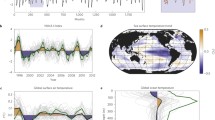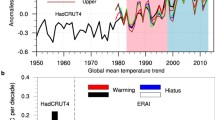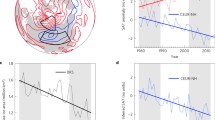Abstract
The Antarctic Peninsula has warmed significantly since the 1950s. This pronounced and isolated warming trend is collectively captured by 29 twentieth-century climate hindcasts participating in the version 3 Coupled Model Intercomparison Project. To understand the factors driving warming trends in the hindcasts, we examine trends in Peninsula region’s atmospheric heat budget in every simulation. We find that atmospheric latent heat release increases in nearly all hindcasts. These increases are generally anthropogenic in origin, and account for about 60% of the ensemble-mean warming trend in the Peninsula. They are driven primarily by well-understood features of the anthropogenic intensification of global hydrological cycle. As sea surface temperature increases, moisture contained in atmospheric flows increases. When such flows are forced to ascend the Peninsula’s topography, enhanced local latent heat release results. The mechanism driving the warming of the Antarctic Peninsula is therefore clear in the models. Evidence for a similar mechanism operating in the real world is seen in the increasing snow accumulation rates inferred from ice cores drilled in the Peninsula. However, the relative importance of this mechanism and other processes previously identified as potentially causing the observed warming, such as the recent sea ice retreat in the Bellingshausen Sea, is difficult to assess. Thus the relevance of the simulated warming mechanism to the observed warming is unclear, in spite of its robustness in the models.











Similar content being viewed by others
References
Alexeev VA, Langen PL, Bates JR (2005) Polar amplification of surface warming on an aquaplanet in “ghost forcing” experiments without sea ice feedbacks. Clim Dyn 24:655–666
Arblaster JM, Meehl GA (2006) Contributions of external forcings to Southern Annular Mode trends. J Clim 19:2896–2905
Boer GJ, Fourest S, Yu B (2001) The signature of the annular modes in the moisture budget. J Clim 14:3655–3665
Cai M, Lu JH (2007) Dynamical greenhouse-plus feedback and polar warming amplification. Part II: Meridional and vertical asymmetries of the global warming. Clim Dyn 29:375–391, doi:10.1007/s00382-007-0238-9
Cai W, Cowan T (2007) Trends in Southern Hemisphere circulation in IPCC AR4 models over 1950-99: Ozone depletion versus greenhouse forcing. J Clim 20:681–693
Chapman W, Walsh JE (2007) A synthesis of Antarctic temperature. J Clim 20:4096–4117
Comiso JC (2000) Variability and trends in Antarctic surface temperatures from in situ and satellite infrared measurements. J Clim 13:1674–1696
Cook AJ, Fox AJ, Vaughan DG, Ferrigno JG (2005) Retreating glacier fronts on the Antarctic Peninsula over the past half-century. Science 308:541–544
Forster P, Ramaswamy V, Artaxo P, Berntsen T, Betts R, Fahey DW, Haywood J, Lean J, Lowe DC, Myhre G, Nganga J, Prinn R, Raga G, Schulz M, Van Dorland R (2007) Changes in Atmospheric Constituents and in Radiative Forcing. In: Solomon S, Qin D, Manning M, Chen Z, Marquis M, Averyt KB, Tignor M, Miller HL (eds) Climate change 2007: the physical science basis. Contribution of working group I to the fourth assessment report of the intergovernmental panel on climate change. Cambridge University Press, Cambridge
Galewsky J (2008) Orographic clouds in terrain-blocked flows: an idealized modeling study. J Atmos Sci 65:3460–3478
Gillett NP, Thompson DWJ (2003) Simulation of recent Southern Hemisphere climate change. Science 302:273–275
Gillett NP, Stone DA, Stott PA, Nozawa T, Karpechko AY, Hegerl GC, Wehner MF, Jones PD (2008) Attribution of polar warming to human influence. Nat Geosci 1:750–754
Gong D, Wang S (1999) Definition of Antarctic oscillation index. Geophys Res Lett 26:459–462
Hartmann D (1994) Atmospheric general circulation and climate. In: Global physical climatology. Academic Press, London, pp 136–170
Held IM, Soden BJ (2006) Robust response of the hydrological cycle to global warming. J Clim 19:5686–5699
Hughes M, Hall A, Fovell RG (2009) Blocking in areas of complex topography, and its influence on rainfall distribution. J Atmos Sci 66:508–518, doi:10.1175/2008JAS2689.1
Jiang Q (2003) Moist dynamics and orographic precipitation. Tellus 55:301316, doi:10.1034/j.1600-0870.2003.00,025.x
Karpechko AY, Gillett NP, Marshall GJ, Screen JA (2009) Climate impacts of the southern annular mode simulated by the CMIP3 models. J Clim 22:375–3768
King JC (1994) Recent climate variability in the vicinity of the Antarctic Peninsula. Int J Climatol 14:357–369
Liu H, Jezek K, Li B, Zhao Z (2001) Radarsat Antarctic mapping project digital elevation model version 2. National Snow and Ice Data Center. Digital media, Boulder
Manabe S, Bryan K, Spelman MJ (1990) Transient response of a global ocean-atmosphere model to a doubling of atmospheric carbon dioxide. J Phys Oceanogr 20:722–749
Marshall GJ (2003) Trends in the Southern Annular Mode from Observations and Reanalyses. J Clim 6:4134–4143
Marshall GJ, Orr A, van Lipzig NPM, King JC (2006) The impact of a changing Southern Hemisphere annular mode on Antarctic Peninsula summer temperatures. J Clim 19:5388–5404
Marshall GJ, Lagun V, Lachlan-Cope TA (2002) Changes in Antarctic Peninsula tropospheric temperatures from 1956–99: a synthesis of observations and reanalysis data. Int J Climatol 22:291–310
Marshall GJ (2007) Half-century seasonal relationships between the Southern Annular Mode and Antarctic temperatures. Int J Climatol 27:373–383
Monaghan AJ, Bromwich DH (2008) Advances in describing recent antarctic climate variability. Bulletin of American Meteorological Society, pp 1295–1306
Monaghan AJ, Bromwich DH, Chapman W, Comiso JC (2008a) Recent variability and trends of Antarctic near-surface temperature. J Geophys Res-Atmos 113:D04105
Monaghan AJ, Bromwich DH, Schneider DP (2008b) Twentieth century Antarctic air temperature and snowfall simulations by IPCC climate models. Geophys Res Lett 35:L07502, doi:10.1029/2007GL032630
Neiman P, Persson P, Ralph F, Jorgensen D, White A, Kingsmill D (2004) Modification of fronts and precipitation by coastal blocking during an intense landfalling winter storm in Southern California: observations during CALJET. Mon Wea Rev 132:242–273
Orr A, Marshall GJ, Hunt JCR, Sommeria J, Wang CG, van Lipzig NPM, Cresswell D, King JC (2008) Characteristics of summer airflow over the Antarctic Peninsula in response to recent strengthening of westerly circumpolar winds. J Atmos Sci 65:1396–1413
Russell JL, Stouffer RJ, Dixon KW (2006) Intercomparison of the Southern Ocean circulations in IPCC coupled model control simulations. J Clim 19:4560–4575
Shepherd A, Wingham D, Payne T, Skvarca P (2003) Larsen ice shelf has progressively thinned. Science 302:856–859
Steig EJ, Schneider DP, Rutherford SD, Mann ME, Comiso JC, Shindell DT (2009) Warming of the Antarctic ice-sheet surface since the 1957 International Geophysical Year. Nature 457:459–463
Thomas ER, Marshall GJ, McConnell JR (2008) A doubling in snow accumulation in the western Antarctic Peninsula since 1850. Geophys Res Lett 35:L01,706, doi:10.1029/2007GL032,529
Thompson DWJ, Solomon S (2002) Interpretation of recent Southern Hemisphere climate change. Science 296:895–899
Thompson DWJ, Wallace JM (2000) Annular modes in the extratropical circulation. Part I: month-to-month variability. J Clim 13:1000–1016
Turner J, Colwell SR, Marshall GJ, Lachlan-Cope TA, Carleton AM, Jones PD, Lagun V, Reide PA, Iagovkinaf S (2004) The SCAR READER project: towards a high-quality database of mean Antarctic meteorological observations. J Clim 17:2890–2898
Turner J, Colwell SR, Marshall GJ, Lachlan-Cope TA, Carleton AM, Jones PD, Lagun V, Reide PA, Iagovkinaf S (2005) Antarctic climate change during the last 50 years. Int J Climatol 25:279–294
Turner J, Lachlan-Cope TA, Colwell S, Marshall GJ, Connolley WM (2006) Significant warming of the Antarctic winter troposphere. Science 311:1914–1917
Turner J, Overland JE, Walsh JE (2007) An Arctic and Antarctic perspective on recent climate change. Int J Climatol 27(3):277–293
van den Broeke MR(2000) On the interpretation of Antarctic temperature trends. J Clim 13:3885–3889
van den Broeke MR, van Lipzig NPM (2004) Changes in Antarctic temperature, wind and precipitation in response to the Antarctic Oscillation. Ann Glaciol 39:119–126
van Lipzig NPM, Marshall GJ, Orr A and King JC (2008) The relationship between the Southern Hemisphere annular mode and Antarctic Peninsula summer temperatures: analysis of a high-resolution model climatology. J Clim 21:1649–1668
Vaughan DG, Doake CSM (1996) Recent atmospheric warming and retreat of ice shelves on the Antarctic Peninsular. Nature 379:328–331
Vaughan DG, Marshall GJ, Connolley WM, Parkinson C, Mulvaney R, Hodgson DA, King JC, Pudsey CJ, Turner J (2003) Recent rapid regional climate warming on the Antarctic Peninsula. Clim Change 60:243–274, doi:10.1023/A:1026021217,991
Acknowledgments
This work was supported by NSF-0735056. We acknowledge the modeling groups, the Program for Climate Model Diagnosis and Intercomparison (PCMDI) and the WCRP’s Working Group on Coupled Modelling (WGCM) for their roles in making available the WCRP CMIP3 multi-model dataset. Support of this dataset is provided by the Office of Science, U.S. Department of Energy. We thank Drs. Andrew Monaghan and William Chapman for their help with the observational data sets, and two anonymous reviewers for their constructive criticisms of our previous manuscript.
Author information
Authors and Affiliations
Corresponding author
Appendix: Information on pre-industrial control experiments
Appendix: Information on pre-industrial control experiments
Some relevant information on pre-industrial control experiments is given in this appendix, including the lengths of the experiments and model drift in surface temperature and latent heat in the Antarctic Peninsula (Table 8).
Rights and permissions
About this article
Cite this article
Qu, X., Hall, A. & Boé, J. Why does the Antarctic Peninsula Warm in climate simulations?. Clim Dyn 38, 913–927 (2012). https://doi.org/10.1007/s00382-011-1092-3
Received:
Accepted:
Published:
Issue Date:
DOI: https://doi.org/10.1007/s00382-011-1092-3




